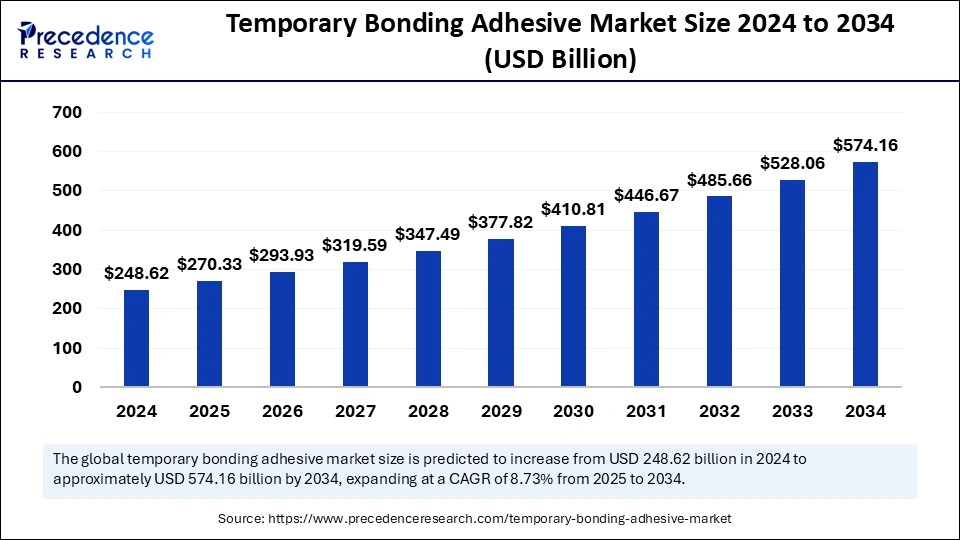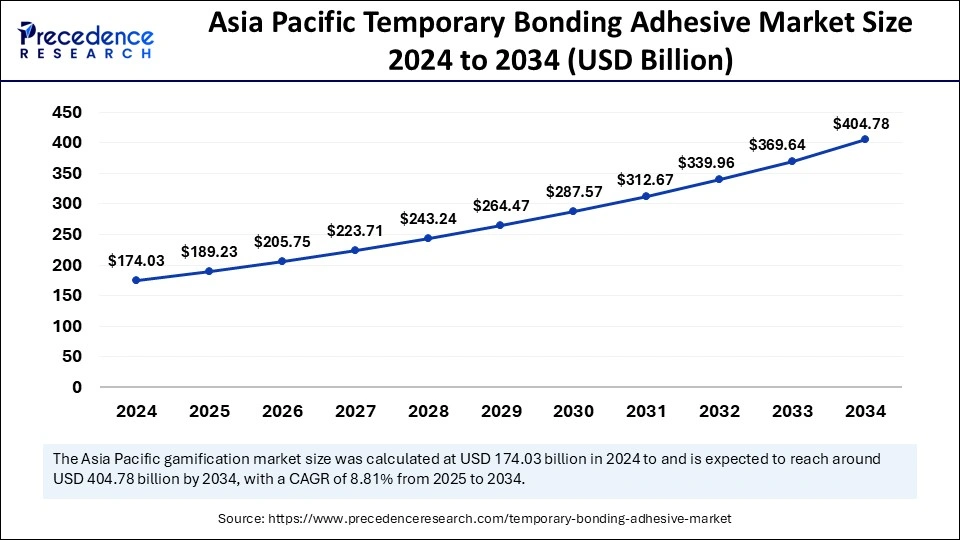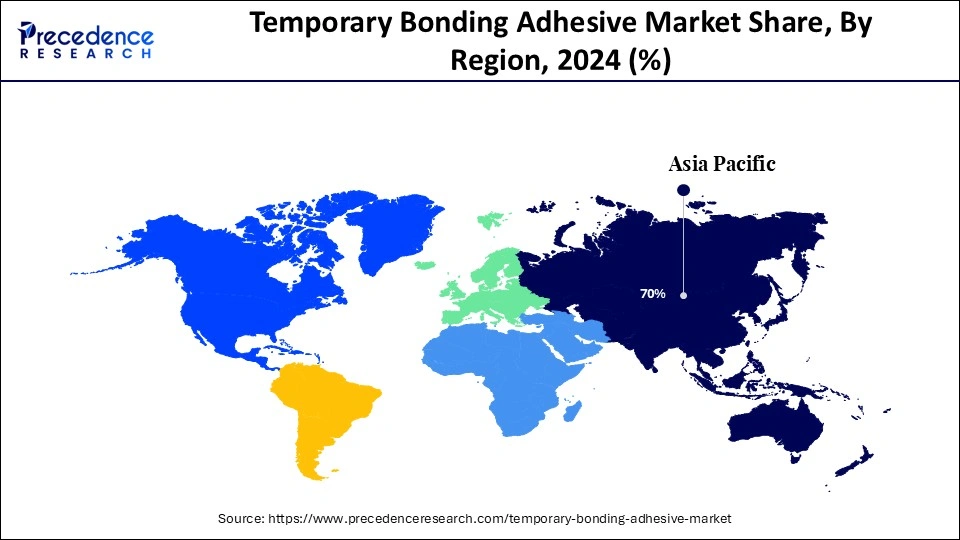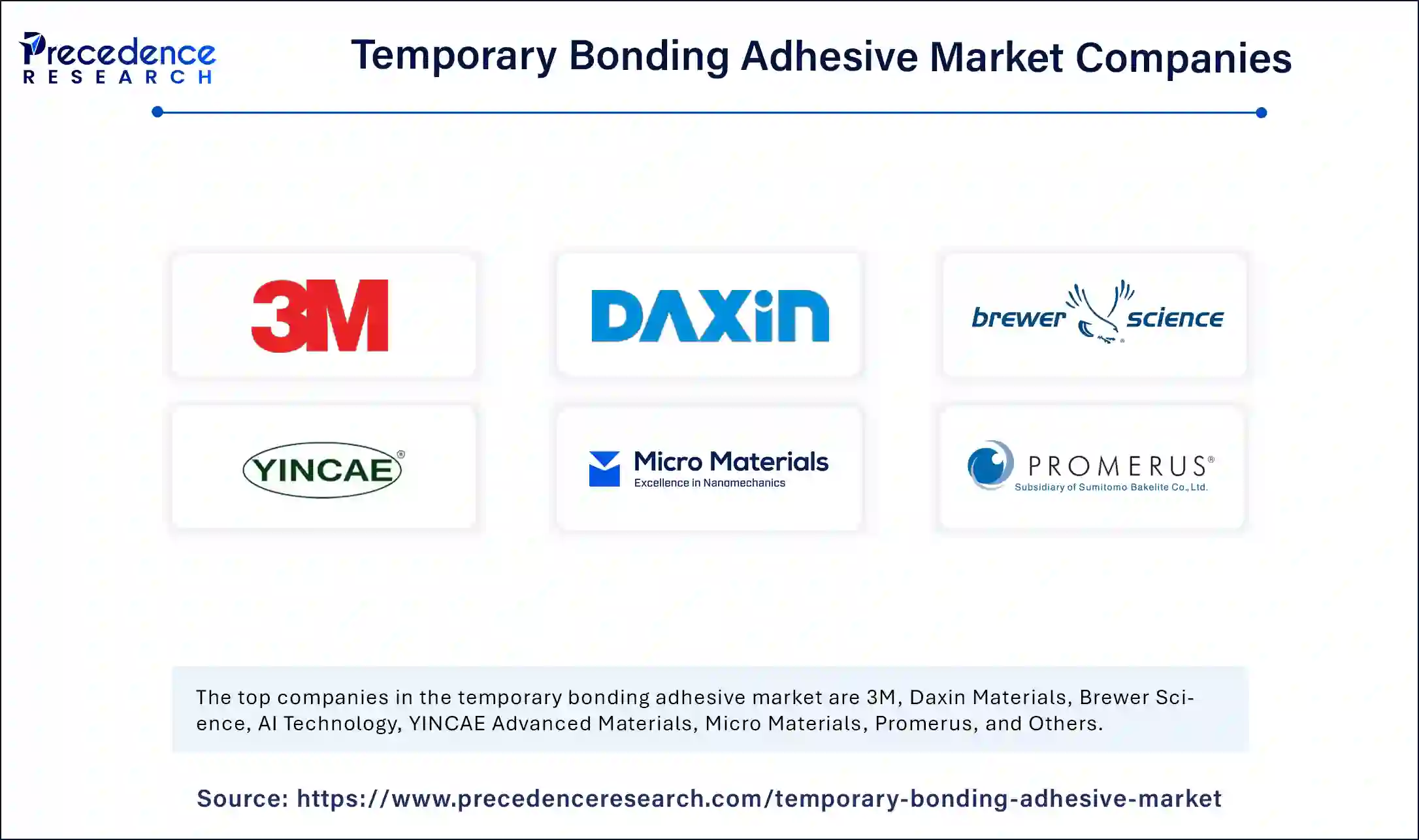August 2024
The global temporary bonding adhesive market size is calculated at USD 270.33 billion in 2025 and is forecasted to reach around USD 574.16 billion by 2034, accelerating at a CAGR of 8.73% from 2025 to 2034. The Asia Pacific market size surpassed USD 174.03 billion in 2024 and is expanding at a CAGR of 8.81% during the forecast period. The market sizing and forecasts are revenue-based (USD Million/Billion), with 2024 as the base year.
The global temporary bonding adhesive market size accounted for USD 248.62 billion in 2024 and is predicted to increase from USD 270.33 billion in 2025 to approximately USD 574.16 billion by 2034, expanding at a CAGR of 8.73% from 2025 to 2034. The rising industrialization across the world and the association of advanced manufacturing technologies and chemicals are driving the growth of the market.

The Asia Pacific temporary bonding adhesive market size was exhibited at USD 174.03 billion in 2024 and is projected to be worth around USD 404.78 billion by 2034, growing at a CAGR of 8.81% from 2025 to 2034.

Asia Pacific dominated the temporary bonding adhesive market in 2024. The growth of the market is attributed to the rising economic development in the regional countries, and industrialization is contributing to the higher demand for the robust adhesive bonding for strengthening the wafer to the surface. The increasing number of automotive, semiconductor, manufacturing, packaging, electronics, and others are accelerating the growth of the market in the region.
Temporary Bonding Adhesive Market in China
China is one of the leading manufacturers of semiconductors and consumer electronics, which accelerates the demand for efficient bonding adhesive for the semiconductor wafer processing, and continuous growing investment by the domestic semiconductor companies on the research and development program is collectively contributing to the growth of the market.
North America is expecting the fastest growth in the market during the predicted period. The growth of the temporary bonding adhesive market is owing to the higher availability of the well-developed industrial infrastructure and the growing investment in specialized technology, chemicals, and materials in the industrial operations that boost the demand for temporary bonding adhesives. The rising disposable income in the population drives the demand for the consumer electronics industry, semiconductor manufacturing, automotive, and others contribute in the growth of the temporary bonding adhesive market across the region.

The United States is one of the leading economies in North America. The availability of the well-developed industrial infrastructure and manufacturing sector is accelerating the demand for industrial technology, and chemicals are driving the demand for the temporary bonding adhesive. Additionally, the rising semiconductor industry in the United States is also contributing to the expansion of the temporary bonding adhesive market.
Europe expects significant growth in the market during the forecast period. Europe consists of a number of economically developed countries, and the development in the electronics and semiconductor industry is contributing to the further demand for the temporary bonding adhesive. The rising development in the chip manufacturing industry in the region is driving the growth of the market.
Temporary bonding adhesive is the specialized adhesive that is made for providing efficient adhesion for the shorter period and can be removed later. Adhesion is reliable for a specific period. Silicone sealants, wood glue, and pressure sensitive tapes are some types of temporary bonding adhesive.
The temporary bonding adhesive is majorly used for applications like promotional stickers, event bandages, and others. It provides reliable strength but can also be removed cleanly when needed; these are the lesser aggressive adhesives as compared to the permanent bonding adhesives. The wider application of the temporary bonding adhesive market in the industries in different operations is accelerating the growth of the market.
| Report Coverage | Details |
| Market Size by 2034 | USD 574.16 Billion |
| Market Size in 2025 | USD 270.33 Billion |
| Market Size in 2024 | USD 248.62 Billion |
| Market Growth Rate from 2025 to 2034 | CAGR of 8.73% |
| Dominated Region | Asia Pacific |
| Fastest Growing Market | North America |
| Base Year | 2024 |
| Forecast Period | 2025 to 2034 |
| Segments Covered | Type, Application, and Regions |
| Regions Covered | North America, Europe, Asia-Pacific, Latin America and Middle East & Africa |
Rise in the automotive industry
The increasing global population, economic development, disposable income in the population, and increasing expenditure on lifestyle and demand for luxury are driving the demand for the automotive industry. The increasing adoption of the temporary bonding adhesive in automotive applications and operations such as surface protection films, high bandage connections, paint masking gifts, automotive gaskets and sealing, Electric Vehicle battery packs, soundproofing materials, vehicle wire harness, EMI applications, and automotive labels.
The automotive adhesive is used to enhance durability and structural integrity, which helps in increasing the lifespan of vehicles. Adhesives are also used in reducing vehicle weight, which enhances the fuel economy and minimizes carbon emission. The adaptation of the bonding adhesives in the different applications in the automotive industry accelerates the growth of the temporary bonding adhesive market.
Limitations of the temporary bonding adhesive
The efficiency of the temporary bonding adhesive is restricted by environmental factors like heat, UV radiations, fluctuating temperature, humidity, and chemical exposure, which reduces the strength of the adhesive and can damage the product. The fluctuation in temperature and environmental factors are one of the major limiting factors of the temporary bonding adhesive market.
Rise in bio-based adhesive technology.
The increasing demand for natural material-based adhesive development is especially made from natural sources like animals and plants. The rising awareness regarding environmental pollution and increasing carbon footprint on the environment drives the demand for sustainable adhesive material that does not emit any carbon particles in the environment. Thus, the increasing demand for biodegradable, sustainable, versatile, and flexible adhesives is driving the development of bio-based bonding adhesives.
The thermal slide-off debonding segment accounted for the largest share of the temporary bonding adhesive market in 2024. The thermal slide-off debonding is one of the significant advancements in the temporary bonding adhesive, which is highly accepted by the packaging, semiconductor, manufacturing, electronics, and others. This type of bonding material depends upon the controlled heating for reducing the carries and water adhesive bond. The thermal slide-off debonding adhesive applied the controlled heating for efficiently debonding wafer and reduced the chances of getting damaged. Further, it helps to maintain the structural integrity. There is a wide range of industries that use thermal slide-off debonding adhesive for a safer separation process with increased accuracy and precision.
The mechanical debonding segment expect notable growth in the market during the forecast period. Mechanical debonding is also known as peel debonding and uses mechanical force to separate the wafer from the carrier. It is one of the important advancements in the debonding adhesive, which eliminates the risk of wafer damaging. It is one of the easiest and simplest forms of debonding adhesive works on room temperature. Operations and is applied in specific applications.
The advanced packaging segment dominated the temporary bonding adhesive market in 2024. The rising population and the growing industrialization and consumer goods industry are driving the demand for the packaging industry, and the further adaptation of the advanced technologies in the packaging industry is driving the association of the temporary bonding adhesive for the high precision, debonding mechanisms, and lowered contamination risk. There are different types of adhesive bonding used in the advanced packaging process, including hot melt adhesive, epoxy adhesive, eutectic bonding, and cyanoacrylates.
The MEMS segment expects substantial growth in the market during the predicted period. The temporary bonding adhesive plays an important role in bonding the MEMS devices or products. There are different types of temporary bonding adhesive used in the MEMS devices and applications such as direct bonding, anodic bonding, adhesive bonding, eutectic bonding, and glass frit bonding. The adhesive used in the MEMS helps in strengthening MEMS wafers at the time of the fabrication of wafers. There is an increasing demand for cost-efficient and improved quality bonding adhesives for strengthening the adhesive bond between MEMS wafers.

By Type
By Application
By Regional
For inquiries regarding discounts, bulk purchases, or customization requests, please contact us at sales@precedenceresearch.com
No cookie-cutter, only authentic analysis – take the 1st step to become a Precedence Research client
August 2024
February 2025
January 2025
February 2025